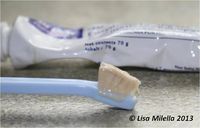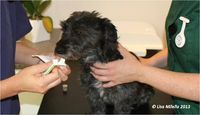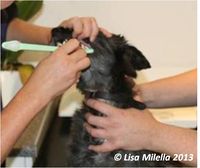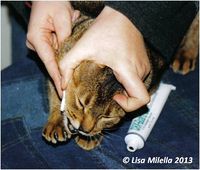Difference between revisions of "Tooth Brushing"
| Line 4: | Line 4: | ||
[[File:Brushing dog teeth.jpg|right|200px|thumb|Brushing dog teeth <small>''© Lisa Milella 2013''</small>]] | [[File:Brushing dog teeth.jpg|right|200px|thumb|Brushing dog teeth <small>''© Lisa Milella 2013''</small>]] | ||
[[File:Brushing cat teeth.jpg|right|200px|thumb|Brushing cat teeth <small>''© Lisa Milella 2013''</small>]] | [[File:Brushing cat teeth.jpg|right|200px|thumb|Brushing cat teeth <small>''© Lisa Milella 2013''</small>]] | ||
| − | The only way to prevent or reduce the risks of [[periodontitis]] is to '''remove plaque on a daily basis'''. Daily tooth brushing is the best way to control plaque accumulation. Understanding the reasons why tooth brushing is important as well as an approach to tooth brushing help increase owner compliance. | + | The only way to prevent or reduce the risks of [[periodontitis]] is to '''remove plaque on a daily basis'''. Daily tooth brushing is the best way to control plaque accumulation. Understanding the reasons why [[:Category:Teeth - Anatomy & Physiology|tooth]] brushing is important as well as an approach to tooth brushing help increase owner compliance. |
| − | Tooth brushing also allows an owner to examine their pet’s mouth daily, enabling them to identify other problems such as fractured teeth or any inflammation that may be regarded as suspicious earlier on, helping to increase the chances of the best treatment. | + | Tooth brushing also allows an owner to examine their pet’s [[Oral Cavity Overview - Anatomy & Physiology|mouth]] daily, enabling them to identify other problems such as fractured teeth or any inflammation that may be regarded as suspicious earlier on, helping to increase the chances of the best treatment. |
==Tooth Brushing Tips == | ==Tooth Brushing Tips == | ||
| − | Many owners introduce brushing too quickly and the animal, young or old, then becomes distressed. It is always advisable to get a pet used to having its '''mouth handled when it is as young''' | + | Many owners introduce brushing too quickly and the animal, young or old, then becomes distressed. It is always advisable to get a pet used to having its '''mouth handled when it is as young as possible''' so that from an early age they learn to accept a level of homecare. Before six months of age the deciduous teeth are present and start to be shed from three-four months of age, with all the permanent teeth finished erupting by the time the kitten or puppy is six months old. Whilst the teeth are erupting, the gingival tissues may be sensitive so introducing a tooth brush at this time is not advisable. It is a useful time to slowly get the pet used to having its mouth handled as well as getting the pet used to the teeth and gums being gently rubbed with some tooth paste. By the time all the permanent teeth are fully erupted, the training part of accepting tooth brushing has already been completed. |
Tooth brushing needs to be '''introduced in a pleasant way'''. Always use a medium bristled toothbrush of a suitable size. A normal adult tooth brush works well in most pets, a smaller compact head size is useful for small dogs and cats. If toothpaste is used it is essential that it is a '''pet toothpaste''' that does '''not contain fluoride''' as pets will swallow the toothpaste and excessive ingestion of fluoride can lead to toxicosis. “Human” tooth pastes also contain frothing agents which a pet would not tolerate and may result in excessive salivation and distress to them whilst tooth brushing. “Human” tooth pastes also contain flavorings like mint that are not liked by many pets. Veterinary toothpastes available are flavoured with either fish or poultry which helps the dog or cat to accept the tooth brush and tooth brushing. Most veterinary tooth pastes also have an enzyme system added to them which helps break up the matrix of the plaque. This '''enzyme system''' occurs in saliva naturally and does work on contact time, so if the tooth paste is swallowed quickly, will not always be of benefit. '''The brushing action is the most important and effective part of tooth brushing.''' | Tooth brushing needs to be '''introduced in a pleasant way'''. Always use a medium bristled toothbrush of a suitable size. A normal adult tooth brush works well in most pets, a smaller compact head size is useful for small dogs and cats. If toothpaste is used it is essential that it is a '''pet toothpaste''' that does '''not contain fluoride''' as pets will swallow the toothpaste and excessive ingestion of fluoride can lead to toxicosis. “Human” tooth pastes also contain frothing agents which a pet would not tolerate and may result in excessive salivation and distress to them whilst tooth brushing. “Human” tooth pastes also contain flavorings like mint that are not liked by many pets. Veterinary toothpastes available are flavoured with either fish or poultry which helps the dog or cat to accept the tooth brush and tooth brushing. Most veterinary tooth pastes also have an enzyme system added to them which helps break up the matrix of the plaque. This '''enzyme system''' occurs in saliva naturally and does work on contact time, so if the tooth paste is swallowed quickly, will not always be of benefit. '''The brushing action is the most important and effective part of tooth brushing.''' | ||
| Line 15: | Line 15: | ||
==Getting Started== | ==Getting Started== | ||
| − | *Check the mouth to ensure that there are no painful areas – resorptive lesions occur at the gingival margin and will be very sensitive if brushed. | + | *Check the mouth to ensure that there are no painful areas – [[|FORL|resorptive lesions]] occur at the gingival margin and will be very sensitive if brushed. |
*Position the pet so that the head is facing away from the operator. For cats, the two best positions are either on the floor, wedged between your thighs or on a table with your cat between you arms and its back against your body. This limits the movement from side to side or backwards. | *Position the pet so that the head is facing away from the operator. For cats, the two best positions are either on the floor, wedged between your thighs or on a table with your cat between you arms and its back against your body. This limits the movement from side to side or backwards. | ||
| Line 39: | Line 39: | ||
[[Category:Oral Hygiene]] | [[Category:Oral Hygiene]] | ||
| − | [[Category:To Do - Dentistry | + | [[Category:To Do - Dentistry preMars]] |
Revision as of 16:39, 16 September 2013
Introduction
The only way to prevent or reduce the risks of periodontitis is to remove plaque on a daily basis. Daily tooth brushing is the best way to control plaque accumulation. Understanding the reasons why tooth brushing is important as well as an approach to tooth brushing help increase owner compliance.
Tooth brushing also allows an owner to examine their pet’s mouth daily, enabling them to identify other problems such as fractured teeth or any inflammation that may be regarded as suspicious earlier on, helping to increase the chances of the best treatment.
Tooth Brushing Tips
Many owners introduce brushing too quickly and the animal, young or old, then becomes distressed. It is always advisable to get a pet used to having its mouth handled when it is as young as possible so that from an early age they learn to accept a level of homecare. Before six months of age the deciduous teeth are present and start to be shed from three-four months of age, with all the permanent teeth finished erupting by the time the kitten or puppy is six months old. Whilst the teeth are erupting, the gingival tissues may be sensitive so introducing a tooth brush at this time is not advisable. It is a useful time to slowly get the pet used to having its mouth handled as well as getting the pet used to the teeth and gums being gently rubbed with some tooth paste. By the time all the permanent teeth are fully erupted, the training part of accepting tooth brushing has already been completed.
Tooth brushing needs to be introduced in a pleasant way. Always use a medium bristled toothbrush of a suitable size. A normal adult tooth brush works well in most pets, a smaller compact head size is useful for small dogs and cats. If toothpaste is used it is essential that it is a pet toothpaste that does not contain fluoride as pets will swallow the toothpaste and excessive ingestion of fluoride can lead to toxicosis. “Human” tooth pastes also contain frothing agents which a pet would not tolerate and may result in excessive salivation and distress to them whilst tooth brushing. “Human” tooth pastes also contain flavorings like mint that are not liked by many pets. Veterinary toothpastes available are flavoured with either fish or poultry which helps the dog or cat to accept the tooth brush and tooth brushing. Most veterinary tooth pastes also have an enzyme system added to them which helps break up the matrix of the plaque. This enzyme system occurs in saliva naturally and does work on contact time, so if the tooth paste is swallowed quickly, will not always be of benefit. The brushing action is the most important and effective part of tooth brushing.
Getting Started
- Check the mouth to ensure that there are no painful areas – [[|FORL|resorptive lesions]] occur at the gingival margin and will be very sensitive if brushed.
- Position the pet so that the head is facing away from the operator. For cats, the two best positions are either on the floor, wedged between your thighs or on a table with your cat between you arms and its back against your body. This limits the movement from side to side or backwards.
- It is important never to approach your pet from the front with a tooth brush as this is very confrontational. Pets will accept tooth brushing much better when the tooth brush is introduced from the side of its face.
- Many owners struggle just holding their cat’s head still – the head should be firmly held with a thumb and forefinger of the non-brushing hand over the zygomatic arch (cheek bone) on either side, and at the same time the lip gently pulled back with the thumb. The head is also just slightly tilted. For dogs, gently hold the mouth closed with the non-tooth brushing hand. This allows better access to the back of the mouth with the tooth brush and also controls head movement.
- Initially use toothpaste on a finger or cotton-bud and gently apply under the lip onto the outer surface of the canine tooth to get the pet used to its mouth being handled as the first step.
- Cotton buds are a good way of getting a cat used to a foreign object in the mouth and often easier than a finger, with a reduced risk of being bitten. Brushes that fit onto your finger are available but are quite bulky to introduce into the cat or small dogs mouth. It is often easier to use a cotton bud or suitably small sized tooth brush.
- Initially aim to clean all the buccal (outer) surfaces of the teeth but then progress to cleaning the palatal and lingual (inner) surfaces – this is not always possible
- The front of the mouth should be brushed last – the incisor area is very sensitive and many pets object, some will sneeze and wriggle when this area is brushed. Ideally clean all the outer surfaces of one side, swap hands, then clean all the outer surfaces of the other side, approaching the incisors last.
- The area of the tooth that needs to be plaque free is the gum margin as this is where the disease interface is. Position the tooth brush so that the bristles just contact the gum.
- There may be some bleeding from the gingiva but this is normal initially and should reduce within the first 5 days. This bleeding is not painful and usually indicates that there are areas of gingivitis or inflammation in the mouth. If the bleeding does not subside, then recommend that the pet see a vet for a dental check as this may indicate a problem that needs treatment for example, there may be an area below the gum margin where plaque is accumulating that needs to be cleaned thoroughly under a general anaesthetic or there may be the start of other pathology like a resorptive lesion.
- The teeth should ideally be brushed daily. Although we know that it takes 48 hours for plaque to build up to a level where it could cause harm, we know that pets accept tooth brushing much better when it becomes part of a routine and is done daily.



